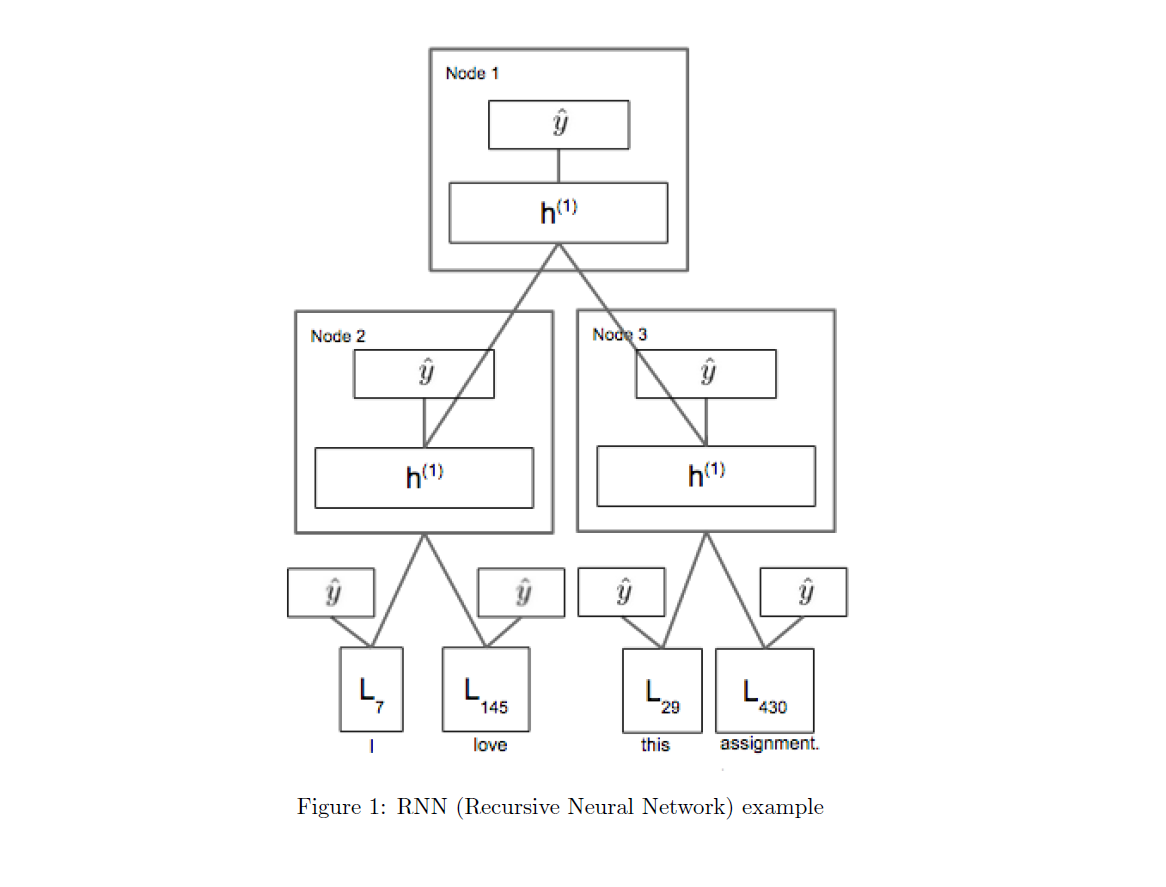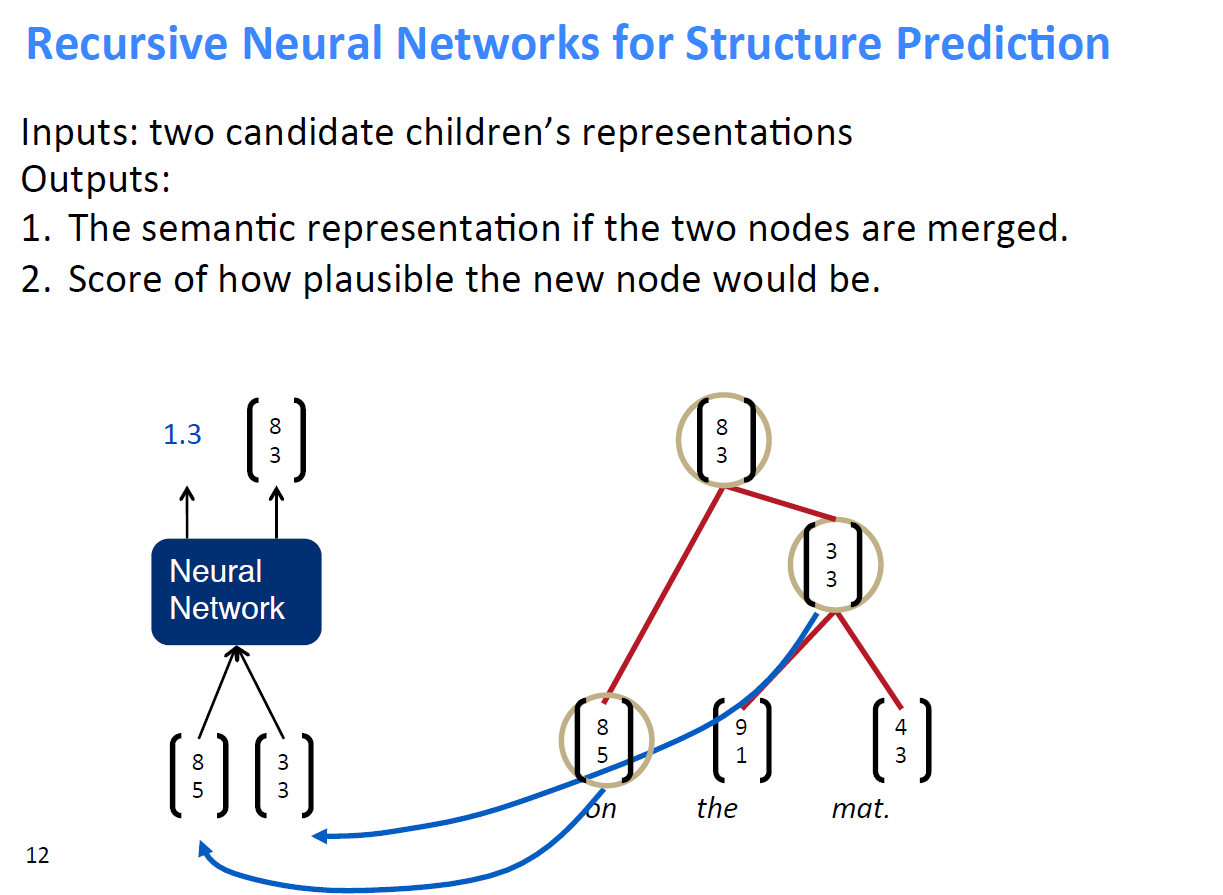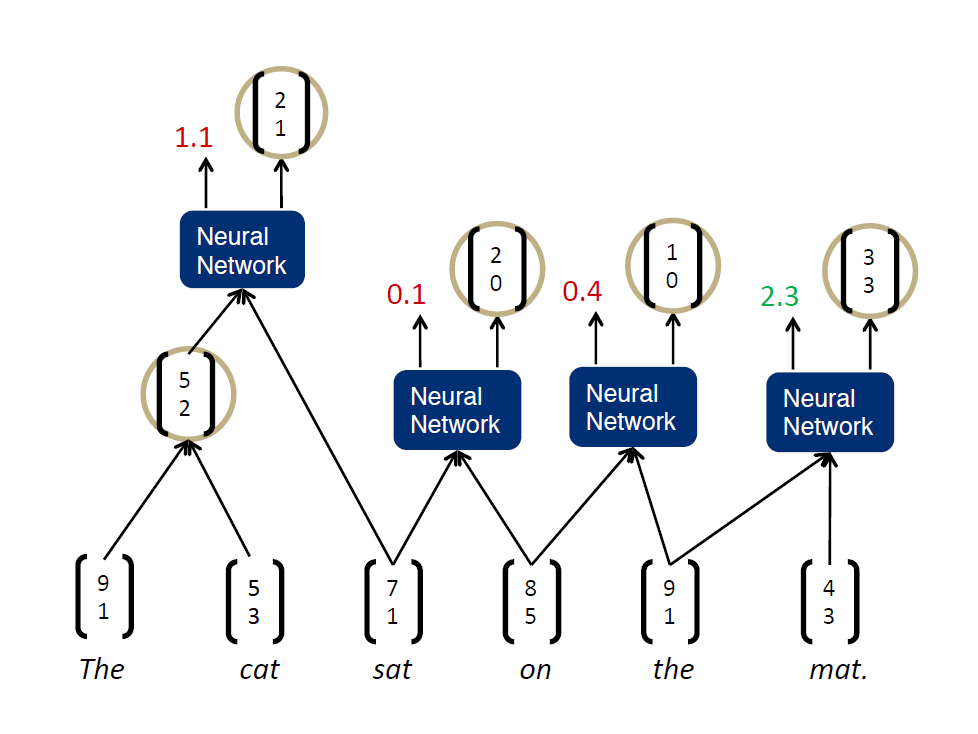cs224d 自然语言处理作业 problem set3 (一) 实现Recursive Nerual Net Work 递归神经网络
1、Recursive Nerual Networks能够更好地体现每个词与词之间语法上的联系
这里我们选取的损失函数仍然是交叉熵函数

2、整个网络的结构如下图所示:



每个参数的更新时的梯队值如何计算,稍后再给大家计算相应的数学公式
这里先列出节点的合并规则




1、即假设将一句话中的词先两个合并,并通过神经网络计算出合并后的得分情况
2、然后找出合并后得分最高的两个词进行真正的合并,得到新的节点,其余节点不合并
3、将得到的新节点加入到下一轮两两合并的计算过程中,直至得到最终节点
下面是计算的代码:
'''
Created on 2017年10月5日 @author: weizhen
'''
# 一个简单的递归神经网络的实现,有着一个ReLU层和一个softmax层
# TODO : 必须要更新前向和后向传递函数
# 你可以通过执行 python rnn.py 方法来执行一个梯度检验
# 插入pdb.set_trace() 在你不确定将会发生什么的地方 import numpy as np
import collections
import pdb
import tree as treeM
import pickle class RNN: def __init__(self, wvecDim, outputDim, numWords, mbSize=30, rho=1e-4):
self.wvecDim = wvecDim
self.outputDim = outputDim
self.numWords = numWords
self.mbSize = mbSize
self.defaultVec = lambda : np.zeros((wvecDim,))
self.rho = rho def initParams(self):
np.random.seed(12341) # Word vectors
self.L = 0.01 * np.random.randn(self.wvecDim, self.numWords) # Hidden layer parameters
self.W = 0.01 * np.random.randn(self.wvecDim, 2 * self.wvecDim)
self.b = np.zeros((self.wvecDim)) # Softmax weights
# note this is " U "in the notes and the handout...
# there is a reason for the change in notation
self.Ws = 0.01 * np.random.randn(self.outputDim, self.wvecDim)
self.bs = np.zeros((self.outputDim)) self.stack = [self.L, self.W, self.b, self.Ws, self.bs] # Gradients
self.dW = np.empty(self.W.shape)
self.db = np.empty((self.wvecDim))
self.dWs = np.empty(self.Ws.shape)
self.dbs = np.empty((self.outputDim)) def costAndGrad(self, mbdata, test=False):
"""
每一个datum在minibatch里边都是一个树
前向计算每一个树,反向传播到每一个树
返回值:
cost:
梯度:w.r.t W,Ws,b,bs
以上变量的梯度都是在稀疏形式存储的
或者是以测试状态下的
Returns:
cost,correctArray,guessArray,total
"""
cost = 0.0
correct = []
guess = []
total = 0.0 self.L, self.W, self.b, self.Ws, self.bs = self.stack
# 初始化所有梯度都是0
self.dW[:] = 0
self.db[:] = 0
self.dWs[:] = 0
self.dbs[:] = 0
self.dL = collections.defaultdict(self.defaultVec) # 在每一个batch中前向计算每一个tree
for tree in mbdata:
c, tot = self.forwardProp(tree.root, correct, guess)
cost += c
total += tot
if test:
return (1. / len(mbdata)) * cost, correct, guess, total # 在每一个batch上进行反向传播
for tree in mbdata:
self.backProp(tree.root) # 通过mb的大小来计算损失和梯度
scale = (1. / self.mbSize)
for v in self.dL.values():
v *= scale # 添加L2正则化项
cost += (self.rho / 2) * np.sum(self.W ** 2)
cost += (self.rho / 2) * np.sum(self.Ws ** 2) return scale * cost, [self.dL, scale * (self.dW + self.rho * self.W), scale * self.db, scale * (self.dWs + self.rho * self.Ws), scale * self.dbs] def forwardProp(self, node, correct=[], guess=[]):
"""损失应该是一个不断更新的变量,总损失是我们需要用在准确率报告里边的数据"""
cost = total = 0.0
# 下面实现递归神经网络前向传播的函数
# 你应该更新 node.probs, node.hActsl,node.fprop,and cost
# node :你当前节点是在语法树上的
# correct : 这是一个不断更新的标记真值的列表
# guess: 这是一个不断更新的猜测我们的模型会预测为哪一个结果的列表
# (我们会同时使用正确的和猜测的值来构造我们的混淆矩阵)
L = self.L
# 隐藏层的参数
W = self.W
b = self.b # Softmax 权重
Ws = self.Ws
bs = self.bs if node.isLeaf:
node.hActsl = L[:, node.word]
else:
if not node.left.fprop:
cost_left, total_left = self.forwardProp(node.left, correct, guess)
cost += cost_left
total += total_left
if not node.right.fprop:
cost_right, total_right = self.forwardProp(node.right, correct, guess)
cost += cost_right
total += total_right node.hActsl = W.dot(np.hstack((node.left.hActsl, node.right.hActsl))) + b
node.hActsl[node.hActsl < 0] = 0 x = Ws.dot(node.hActsl) + bs
x -= np.max(x)
node.probs = np.exp(x) / np.sum(np.exp(x)) correct += [node.label]
guess += [np.argmax(node.probs)] cost -= np.log(node.probs[node.label]) node.fprop = True return cost, total + 1 def backProp(self, node, error=None):
"""
实现递归神经网络的反向传播函数
应该更新 self.dWs, self.dbs, self.dW, self.db, and self.dL[node.word] 相关地
node:你在语法树种的当前节点
error:误差从之前一个迭代过程中传递进来的
"""
# 清空节点
node.fprop = False L = self.L
# 隐藏节点的参数
W = self.W
b = self.b # Softmax层的权重
Ws = self.Ws
bs = self.bs error_this = node.probs
error_this[node.label] -= 1.0
delta = Ws.T.dot(error_this) self.dWs += np.outer(error_this, node.hActsl)
self.dbs += error_this if error is not None:
delta += error delta[node.hActsl == 0] = 0 if node.isLeaf:
self.dL[node.word] += delta
else:
self.dW += np.outer(delta, np.hstack([node.left.hActsl, node.right.hActsl]))
self.db += delta delta = np.dot(self.W.T, delta)
self.backProp(node.left, delta[:self.wvecDim])
self.backProp(node.right, delta[self.wvecDim:]) def updateParams(self, scale, update, log=False):
"""
如下这样更新参数
p:=p-scale*update
如果log是真的,输出根节点的均方误差,并且更新根节点的值
"""
if log:
for P, dP in zip(self.stack[1:], update[1:]):
pRMS = np.sqrt(np.mean(P ** 2))
dpRMS = np.sqrt(np.mean((scale * dP) ** 2))
print("weight rms=%f -- update rms=%f" % (pRMS, dpRMS))
self.stack[1:] = [P + scale * dP for P, dP in zip(self.stack[1:], update[1:])] # 解决词典并且进行稀疏的更新
dL = update[0]
for j in dL.iterkeys():
self.L[:, j] += scale.dL[j] def toFile(self, fid):
pickle.dump(self.stack, fid) def fromFile(self, fid):
self.stack = pickle.load(fid) def check_grad(self, data, epsilon=1e-6):
cost, grad = self.costAndGrad(data) err1 = 0.0
count = 0.0
print("Checking dW...")
for W, dW in zip(self.stack[1:], grad[1:]):
W = W[..., None]
dW = dW[..., None]
for i in range(W.shape[0]):
for j in range(W.shape[1]):
W[i, j] += epsilon
costP, _ = self.costAndGrad(data)
W[i, j] -= epsilon
numGrad = (costP - cost) / epsilon
err = np.abs(dW[i, j] - numGrad)
err1 += err
count += 1
if 0.001 > err1 / count:
print("Grad Check Passed for dW")
else:
print("Grad Check Failed for dW:Sum of Error=%.9f" % (err1 / count)) # check dL separately since dict
dL = grad[0]
L = self.stack[0]
err2 = 0.0
count = 0.0
print("Checking dL...")
for j in dL.keys():
for i in range(L.shape[0]):
L[i, j] += epsilon
costP, _ = self.costAndGrad(data)
L[i, j] -= epsilon
numGrad = (costP - cost) / epsilon
err = np.abs(dL[j][i] - numGrad)
err2 += err
count += 1
if 0.001 > err2 / count:
print("Grad Check Passed for dL")
else:
print("Grad Check Failed for dL: Sum of Error = %.9f" % (err2 / count)) if __name__ == '__main__': train = treeM.loadTrees()
numW = len(treeM.loadWordMap()) wvecDim = 10
outputDim = 5 rnn = RNN(wvecDim, outputDim, numW, mbSize=4)
rnn.initParams() mbData = train[:4]
print("Numerical gradient check...")
rnn.check_grad(mbData)
下面部分是构造节点的python文件tree.py
在进行计算时需要先运行tree.py文件进行tree结构的生成,然后进行合并计算
import collections
import pickle
UNK = 'UNK'
# This file contains the dataset in a useful way. We populate a list of Trees to train/test our Neural Nets such that each Tree contains any number of Node objects. # The best way to get a feel for how these objects are used in the program is to drop pdb.set_trace() in a few places throughout the codebase
# to see how the trees are used.. look where loadtrees() is called etc.. class Node: # a node in the tree
def __init__(self,label,word=None):
self.label = label
self.word = word # NOT a word vector, but index into L.. i.e. wvec = L[:,node.word]
self.parent = None # reference to parent
self.left = None # reference to left child
self.right = None # reference to right child
self.isLeaf = False # true if I am a leaf (could have probably derived this from if I have a word)
self.fprop = False # true if we have finished performing fowardprop on this node (note, there are many ways to implement the recursion.. some might not require this flag)
self.hActs1 = None # h1 from the handout
self.hActs2 = None # h2 from the handout (only used for RNN2)
self.probs = None # yhat class Tree: def __init__(self,treeString,openChar='(',closeChar=')'):
tokens = []
self.open = '('
self.close = ')'
for toks in treeString.strip().split():
tokens += list(toks)
self.root = self.parse(tokens) def parse(self, tokens, parent=None):
assert tokens[0] == self.open, "Malformed tree"
assert tokens[-1] == self.close, "Malformed tree" split = 2 # position after open and label
countOpen = countClose = 0 if tokens[split] == self.open:
countOpen += 1
split += 1
# Find where left child and right child split
while countOpen != countClose:
if tokens[split] == self.open:
countOpen += 1
if tokens[split] == self.close:
countClose += 1
split += 1 # New node
node = Node(int(tokens[1])) # zero index labels node.parent = parent # leaf Node
if countOpen == 0:
node.word = ''.join(tokens[2:-1]).lower() # lower case?
node.isLeaf = True
return node node.left = self.parse(tokens[2:split],parent=node)
node.right = self.parse(tokens[split:-1],parent=node) return node def leftTraverse(root,nodeFn=None,args=None):
"""
Recursive function traverses tree
from left to right.
Calls nodeFn at each node
"""
nodeFn(root,args)
if root.left is not None:
leftTraverse(root.left,nodeFn,args)
if root.right is not None:
leftTraverse(root.right,nodeFn,args) def countWords(node,words):
if node.isLeaf:
words[node.word] += 1 def clearFprop(node,words):
node.fprop = False def mapWords(node,wordMap):
if node.isLeaf:
if node.word not in wordMap:
node.word = wordMap[UNK]
else:
node.word = wordMap[node.word] def loadWordMap():
with open('wordMap.bin','rb') as fid:
return pickle.load(fid) def buildWordMap():
"""
Builds map of all words in training set
to integer values.
""" file = 'trees/train.txt'
print("Reading trees to build word map..")
with open(file,'r') as fid:
trees = [Tree(l) for l in fid.readlines()] print("Counting words to give each word an index..") words = collections.defaultdict(int)
for tree in trees:
leftTraverse(tree.root,nodeFn=countWords,args=words) wordMap = dict(zip(words.keys(),range(len(words))))
wordMap[UNK] = len(words) # Add unknown as word print("Saving wordMap to wordMap.bin")
with open('wordMap.bin','wb') as fid:
pickle.dump(wordMap,fid) def loadTrees(dataSet='train'):
"""
Loads training trees. Maps leaf node words to word ids.
"""
wordMap = loadWordMap()
file = 'trees/%s.txt'%dataSet
print("Loading %sing trees.."%dataSet)
with open(file,'r') as fid:
trees = [Tree(l) for l in fid.readlines()]
for tree in trees:
leftTraverse(tree.root,nodeFn=mapWords,args=wordMap)
return trees if __name__=='__main__':
buildWordMap() train = loadTrees() print("Now you can do something with this list of trees!")
更详细的代码请参考github:
https://github.com/weizhenzhao/cs224d_problem_set3
cs224d 自然语言处理作业 problem set3 (一) 实现Recursive Nerual Net Work 递归神经网络的更多相关文章
- cs224d 作业 problem set3 (一) 实现Recursive Nerual Net Work 递归神经网络
1.Recursive Nerual Networks能够更好地体现每个词与词之间语法上的联系这里我们选取的损失函数仍然是交叉熵函数 2.整个网络的结构如下图所示: 每个参数的更新时的梯队值如何计算, ...
- cs224d 作业 problem set2 (三) 用RNNLM模型实现Language Model,来预测下一个单词的出现
今天将的还是cs224d 的problem set2 的第三部分习题, 原来国外大学的系统难度真的如此之大,相比之下还是默默地再天朝继续搬砖吧 下面讲述一下RNN语言建模的数学公式: 给出一串连续 ...
- cs224d 作业 problem set2 (一) 用tensorflow纯手写实现sofmax 函数,线性判别分析,命名实体识别
Hi Dear Today we will use tensorflow to implement the softmax regression and linear classifier algor ...
- cs224d 作业 problem set2 (二) TensorFlow 实现命名实体识别
神经网络在命名实体识别中的应用 所有的这些包括之前的两篇都可以通过tensorflow 模型的托管部署到 google cloud 上面,发布成restful接口,从而与任何的ERP,CRM系统集成. ...
- cs224d 作业 problem set1 (二) 简单的情感分析
使用在上一篇博客中训练好的wordvector 在这一节进行情感分析. 因为在上一节中得到的是一个词就是一个向量 所以一句话便是一个矩阵,矩阵的每一列表示一个词向量 情感分析的前提是已知一句话是 (超 ...
- cs224d 作业 problem set1 (一) 主要是实现word2vector模型,SGD,CBOW,Softmax,算法
''' Created on 2017年9月13日 @author: weizhen ''' import numpy as np def sigmoid(x): return 1 / (1 + np ...
- 【NLP】自然语言处理:词向量和语言模型
声明: 这是转载自LICSTAR博士的牛文,原文载于此:http://licstar.net/archives/328 这篇博客是我看了半年的论文后,自己对 Deep Learning 在 NLP 领 ...
- Deep Learning in NLP (一)词向量和语言模型
原文转载:http://licstar.net/archives/328 Deep Learning 算法已经在图像和音频领域取得了惊人的成果,但是在 NLP 领域中尚未见到如此激动人心的结果.关于这 ...
- Deep Learning In NLP 神经网络与词向量
0. 词向量是什么 自然语言理解的问题要转化为机器学习的问题,第一步肯定是要找一种方法把这些符号数学化. NLP 中最直观,也是到目前为止最常用的词表示方法是 One-hot Representati ...
随机推荐
- python3 安装及项目管理安装
python3 一.下载安装 地址:https://www.python.org/downloads/ 安装:傻瓜式安装:我的目录如下 二.环境配置 [右键计算机]-->[属性]-->[高 ...
- G1垃圾收集器和CMS垃圾收集器 (http://mm.fancymore.com/reading/G1-CMS%E5%9E%83%E5%9C%BE%E7%AE%97%E6%B3%95.html#toc_8)
参考来源 JVM 体系架构 堆/栈的内存分配 静态和非静态方法的内存分配 CMS 回收算法 应用场景 CMS 垃圾收集阶段划分(Collection Phases) CMS什么时候启动 CMS缺点 G ...
- 10分钟搞懂Tensorflow 逻辑回归实现手写识别
1. Tensorflow 逻辑回归实现手写识别 1.1. 逻辑回归原理 1.1.1. 逻辑回归 1.1.2. 损失函数 1.2. 实例:手写识别系统 1.1. 逻辑回归原理 1.1.1. 逻辑回归 ...
- 阿里云centos下安装nginx、jdk、tomcat、绑定域名、解析域名
1.ESC后安全设置(管理控制台->本实例安全组->配置规则->添加安全组规则->3306.80端口配置) 2.nginx 安装,首先安装三大件 PCRE.zlib.ope ...
- Socket通信中AF_INET 和 AF_UNIX域的区别
转载:http://blog.csdn.net/sandware/article/details/40923491 1. AF_INET域socket通信过程 典型的TCP/IP四层模型的通信过程. ...
- Mac 下如何使用sed -i命令
今天在学习Linux的过程中发现了sed这一项指令 首先,sed的全称是:Stream Editor 调用sed命令有两种形式: sed [options] 'command' file(s) sed ...
- 【集美大学1411_助教博客】团队作业10——项目复审与事后分析(Beta版本)
写在前面的话 软件工程课结束了,大家开心吗?是不是再也不用熬夜写代码了?如果这门课你真的熬夜写代码了,相信你一定有收获,如果这门课结束了你觉得是自己一个全新的开始,那么这门课的意义就实现了.团队作业全 ...
- 团队作业4——第一次项目冲刺(Alpha版本) 4.23
团队作业4--第一次项目冲刺(Alpha版本) Day two: 会议照片 每日站立会议: 项目进展 今天是项目的Alpha敏捷冲刺的第二天,先大概整理下昨天已完成的任务以及今天计划完成的任务.今天主 ...
- 201521123001《Java程序设计》第8周学习总结
1. 本周学习总结 1.1 以你喜欢的方式(思维导图或其他)归纳总结集合与泛型相关内容. 2. 书面作业 本次作业题集集合 List中指定元素的删除(题目4-1) 1.1 实验总结 答: 在老师的详细 ...
- 201521123038 《Java程序设计》 第三周学习总结
201521123038 <Java程序设计> 第三周学习总结 1. 本周学习总结 附大图链接 http://naotu.baidu.com/file/5774caa2be710afbc0 ...
